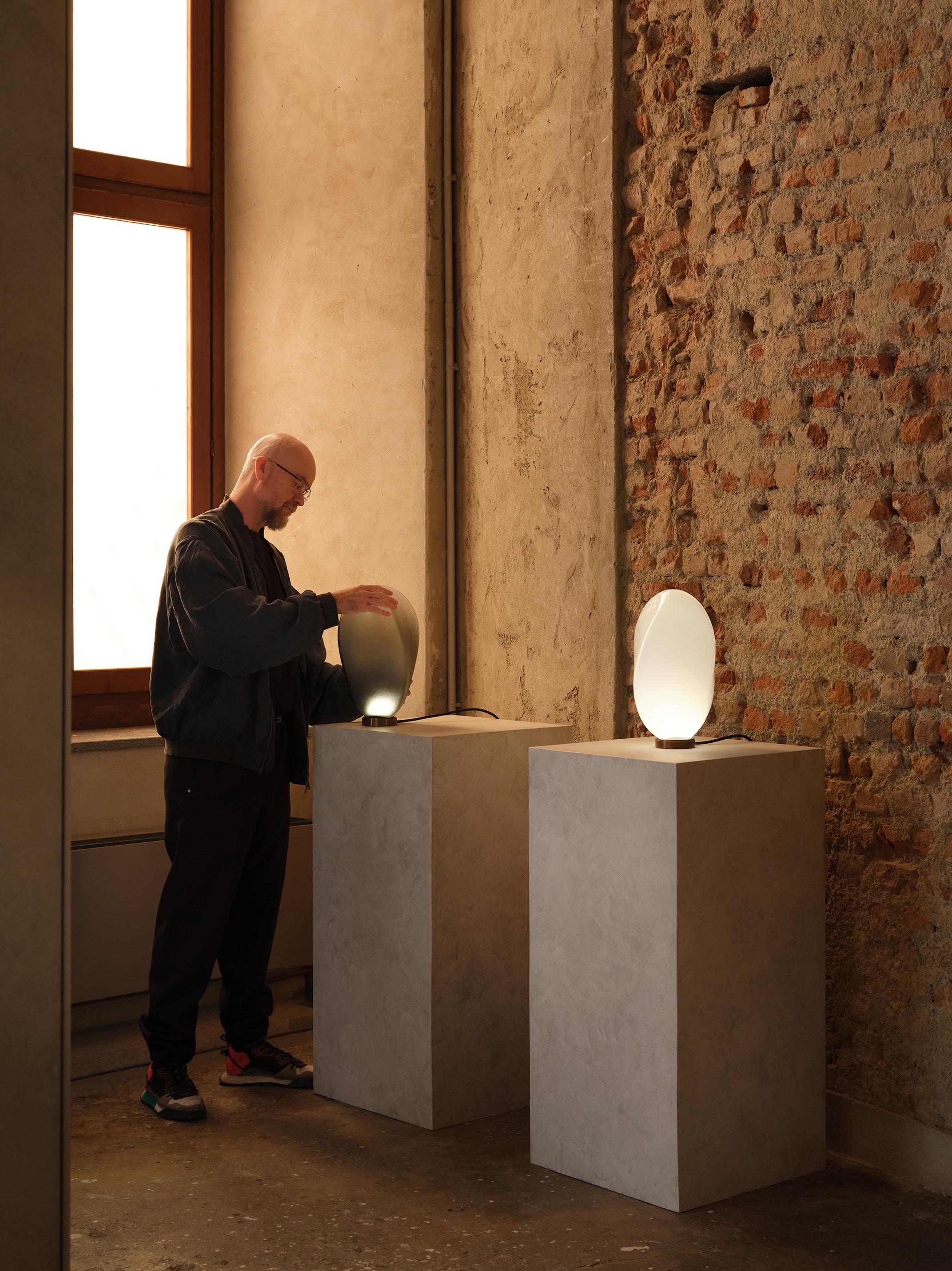
6 minute read
Design Voices: Ross Gardam
PHOTOGRAPHY DePasquale+Maffini INTERVIEW Sophie Lewis
DUAL FORCES
Based in Melbourne, lighting designer Ross Gardam is known for his innovative approach to glass. For Milan Design Week 2025, the designer presented LUMINESCENT DUALITY within an old icehouse in the city’s Brera district. The exhibition explored the theme of light as a medium and metaphor, as Gardam unveiled new handcrafted and limited edition pieces.

Congratulations on LUMINESCENT DUALITY, presented at Milan Design Week 2025. How did French philosopher, scientist, and mathematician René Descartes’ opening appeal in Meditations Métaphysiques shape your approach to the show?
Ross Gardam: Duality within perception was the overarching theme of the show. Descartes frames the physical and emotional aspects of perception so poetically that I was drawn to the text: “I will now close my eyes, stop my ears, and withdraw all my senses. I will consider these ideas purely within myself.”
Why did you choose the space in Milan’s Brera district for LUMINESCENT DUALITY?
Ross Gardam: The space was initially used as an icehouse before the advent of refrigeration, and I had attended many great exhibitions in this space over the years. Via Palermo has always felt like the centre of Brera, since I first travelled for design week in 2010.
Given the historic nature of the space, how did its atmosphere or past influence the design of your freestanding installation?
Ross Gardam: The architecture framed the work perfectly, and the golden light from the arched windows created a dream-like feel to the experience. The heritage nature of the space also offered us the opportunity to create a skeleton within, as we could not touch the original walls or ceiling. Initially, I aimed to create the ambience of a pavilion space; however, this was softened over time with the addition of curtains and soft tones. The physicality of the installation was designed to be sympathetic to the new collections launched, using dual connection points throughout.
The exhibition featured both new and limited-edition pieces. How do the showcased works, particularly the debut of Aeris and Solace and the international debut of Volant, reflect the evolution of your relationship with glass?
Ross Gardam: All of the new collections build on what has come before. Solace is a particularly complex form to create in mouth-blown glass. Fortunately, we had the privilege of working with our long-time collaborator, Liam Fleming, on the pieces.
I have been working with mouth-blown glass since my first lighting piece, Silhouette, and I have not found a material that pairs better with light. My relationship with glass is defined by a curiosity to explore new ground, in form and process.
In Aeris, you translate the ephemeral nature of clouds into sculptural light. How did you capture that sense of softness and suspension through the interaction between mouth-blown glass and brass?
Ross Gardam: The white glass especially has such a literal translation to billowing clouds. It's also the close-up view of each pearlescent piece of glass, which has an amazing depth that mimics clouds. The other glass finishes have a subtleness to them, with the light reflecting internally, which talks to the sky.


Many visitors froze on entry and then travelled through in hushed tones. We created a moment, separate from the chaotic streets and the hectic nature of Milan Design Week. I wanted the experience to push people out of their place, just for a small moment in time.
– Ross Gardam
In Solace, you push the boundaries of traditional glassblowing through innovative engineering. How did this affect the collection’s intricate, textured forms?
Ross Gardam: Unlike other glass we produce, Solace is blown into a static mould, so the glass comes into contact with the cast iron mould and chills immediately. This creates the beautiful rippling effect on the surface of each piece.
Both collections are handcrafted in Australia and assembled in your Melbourne studio. What is the importance of this local, hands-on process to the character and integrity of each piece?
Ross Gardam: This is something we have been focused on since the business's inception, allowing our small studio to consistently deliver the highest quality possible.
You also launched Relic, your second collaboration with glass sculptor Peter Kovacsy. How did working together impact the way glass and light come across in the piece?
Ross Gardam: I will not lie, Relic was laboured over; it was challenging to create a second piece to sit alongside Vestige. The material in this scale has such a mesmerising effect on people, and I had a better understanding of how I wanted to use this within Relic. Relic is not a singular form, it has layers upon layers. When illuminated, it draws you into the open front of the piece.
How did you navigate the complexity of cast crystal glass while maintaining the purity of its geometric silhouette?
Ross Gardam: Relic intentionally bears the mark of the making process. As the crystals melt in the kiln, they form ghosting and air bubbles as they kiss together. Each piece is delicately excavated from the sacrificial mould after 14 days of annealing, releasing a form scarred by the process. The face is then polished to a high-gloss finish. The geometric silhouette was designed to be elegant as a singular object, while also being accessible and allowing for a more detailed view of the contrasting surfaces.
LUMINESCENT DUALITY invited reflection on light as both a medium and a metaphor for life’s contrasts. What did you hope visitors would take away from the show?
Ross Gardam: Many visitors froze on entry and then travelled through in hushed tones. We created a moment, separate from the chaotic streets and the hectic nature of Milan Design Week. I wanted the experience to push people out of their place, just for a small moment in time.











